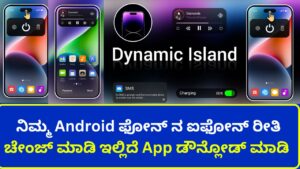i phone Dynamic : ನಿಮ್ಮ Android ಫೋನ್ ನ ಐಫೋನ್ ರೀತಿ ಚೇಂಜ್ ಮಾಡಿ ಇಲ್ಲಿದೆ App ಡೌನ್ಲೋಡ್ ಮಾಡಿ
Dynamic Island for Android: A New Frontier in Smartphone Interaction
In the ever-evolving world of smartphone technology, user experience (UX) stands at the forefront of innovation. Apple, known for its sleek designs and seamless user interfaces, introduced the Dynamic Island feature with the release of the iPhone 14 Pro models. This feature has captured the attention of tech enthusiasts and everyday users alike, primarily because of its unique approach to multitasking and notification management. Now, there’s growing interest in how this concept could translate to Android devices. This article explores what the Dynamic Island feature is, why it’s significant, and how it could be adapted and potentially enhanced on the Android platform.

Understanding the Dynamic Island
Dynamic Island is a design and functional innovation that transforms the iPhone’s notch—typically a static space housing the front camera and Face ID sensors—into an interactive element of the user interface. Instead of being a mere obstruction, the Dynamic Island is dynamic (hence the name) and changes shape and size to display notifications, controls, or other information. For example, when playing music, the island expands to show album art and playback controls. When receiving a call, it grows to provide quick access to answer or decline options without leaving the current app. This concept enhances multitasking, allowing users to interact with background tasks seamlessly.
Why Dynamic Island Matters
The significance of Dynamic Island lies in its ability to blend form and function in a way that enhances the user experience. Traditional notifications often disrupt the current activity by pulling the user out of their workflow. Dynamic Island, however, provides a less intrusive alternative. It allows for quick interactions—such as controlling music, answering calls, or checking navigation—without interrupting the primary activity. This is particularly useful in a world where multitasking is increasingly the norm.
Furthermore, the Dynamic Island offers a new layer of customization and personalization. Since it can dynamically adjust based on the user’s actions, it provides a more engaging and interactive experience. For instance, the island can shrink to show minimal information or expand to provide more detailed controls, giving users more autonomy over how they interact with their devices.
The Potential of Dynamic Island on Android
The introduction of Dynamic Island has sparked curiosity about how similar features could be implemented on Android devices. Android, known for its flexibility and customization, offers a fertile ground for such innovations. The key difference between Android and iOS lies in the operating systems’ openness; Android allows more freedom for developers and users to customize and enhance the user interface. This could mean that a Dynamic Island-like feature on Android might not only replicate but also surpass the functionality seen on iPhones.
1. Customization Opportunities:
Android users are accustomed to a high degree of customization, from widgets to third-party launchers. A Dynamic Island feature on Android could potentially offer more customization options than its iOS counterpart. Users might be able to choose what types of notifications or controls appear in the island, adjust its size and position, or even download third-party modules to enhance its capabilities.
2. Leveraging Android’s Notification System:
Android’s notification system is already highly regarded for its richness and flexibility. Incorporating a Dynamic Island-like feature could integrate even more deeply with these notifications, allowing for richer interactions directly within the “island” area. For example, replying to messages, expanding notifications to show more information, or accessing quick actions could all be streamlined through this interface.
3. Compatibility with Different Screen Sizes and Shapes:
Android devices come in a myriad of screen sizes and shapes, from traditional smartphones to foldables and rollables. A Dynamic Island feature could be adapted to take advantage of this diversity, offering unique implementations depending on the device. For example, on a foldable phone, the island could span the hinge area when the device is partially folded, providing a new way to interact with the phone in “tent” mode.
4. Third-Party Developer Ecosystem:
Android’s open ecosystem could allow third-party developers to create apps that leverage the Dynamic Island concept. This could lead to a wide range of innovative uses, from gaming interfaces to productivity tools, that make full use of this new UI element.
Challenges and Considerations
While the potential for a Dynamic Island on Android is exciting, there are challenges and considerations to keep in mind:
1. Fragmentation:
Android’s greatest strength—its diversity—is also its greatest weakness when it comes to uniform feature implementation. Unlike iOS, where Apple controls both the hardware and software, Android is an open ecosystem with numerous manufacturers, each with different hardware designs and software customizations. This fragmentation could make it difficult to create a consistent Dynamic Island experience across all Android devices.
2. User Learning Curve:
Introducing a new UI element requires users to learn new interaction methods. While the Dynamic Island is intuitive, there will still be a learning curve for users unfamiliar with the concept. Ensuring that the feature is easy to use and enhances, rather than complicates, the user experience will be crucial.
3. Battery and Performance Impact:
Dynamic elements that are always visible and potentially always active can have implications for battery life and device performance. Developers would need to optimize the feature to ensure it does not drain resources unnecessarily.
Conclusion
The Dynamic Island is an innovative concept that has reimagined how users interact with their smartphones, providing a more fluid and less intrusive way to manage tasks and notifications. For Android, the potential to adopt and adapt this feature presents an exciting opportunity to push the boundaries of smartphone UX further. By leveraging Android’s strengths—customization, a robust notification system, diverse hardware, and an open developer ecosystem—a Dynamic Island feature on Android could not only replicate the success of its iOS counterpart but also offer an even richer, more versatile experience. However, careful consideration of the challenges will be necessary to ensure it enhances the user experience across the diverse Android landscape.
